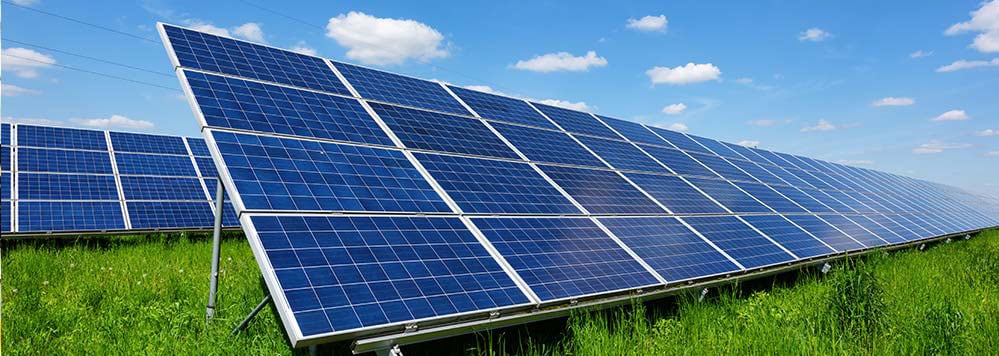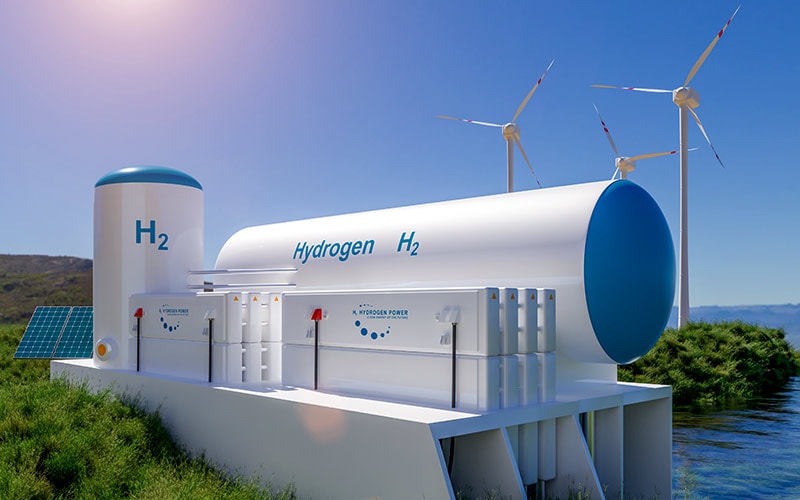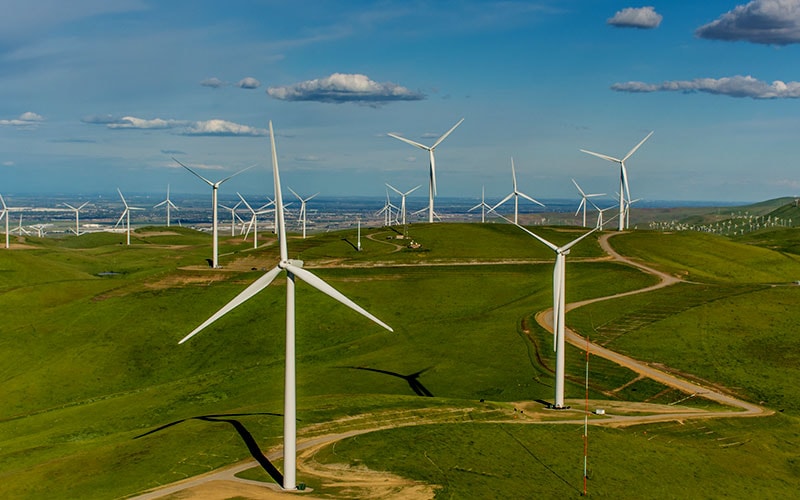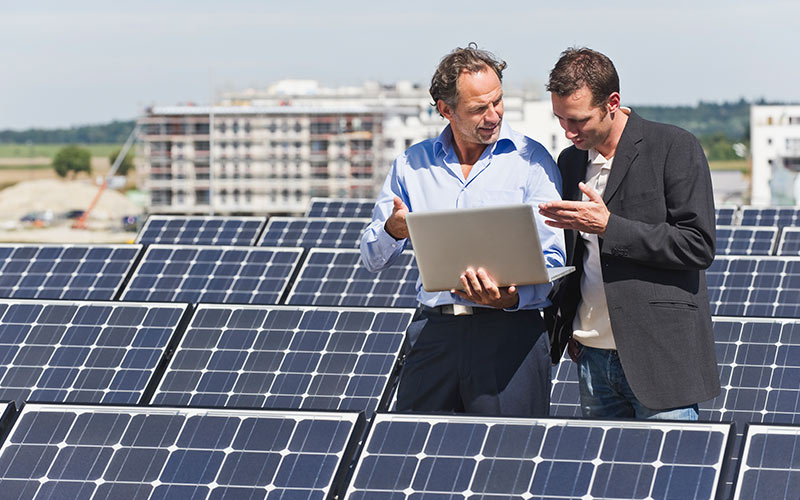Renewable energy is increasingly affordable, good for the environment and here to stay. The problem is that the nation’s electrical grid isn’t ready for it. The grid was not built for the kind of fluctuating supply that comes from distributed energy generation. In addition to the increased supply volatility associated with distributed energy resources, utilities are confronted with increased demands on the grid from electrification and digitization of the economy. Customer expectations for consumer-grade digital experiences and increased emphasis on safety and reliability are only increasing.
Ready or not: tougher state regulations
When it comes to grid modernization, the clock is ticking. More than half the states have established renewable portfolio standards, requiring utilities to generate a percentage of electricity sold from renewable resources. Renewables already account for about 17% of U.S. electricity generation.1 State energy policies are driving this growth. State requirements are responsible for about 50% of the growth in U.S. renewable energy generation since 2000.2 As you can see in Figure 1, Washington, D.C., has a 100% renewable energy mandate by 2032. California, Hawaii and Washington will require 100% renewable energy by 2045.
California is an example of a state with a clear vision for making the most of Distributed Energy Resources (DERs). It’s using both legislation and regulation to realize their potential. Starting in 2020, solar panels will be required on all new houses built in California, with an exception for houses that are often shaded. There are also incentives for homeowners to add a high-capacity battery. This will allow their home’s electrical system to store solar energy for later use when the sun isn’t shining and their solar panels aren’t generating electricity, thereby helping to mitigate the volatility inherent in many renewable sources like solar and wind energy. There’s hope for a future where renewables are a major power source, reducing carbon emissions and managing demand, but this won’t happen without modernizing the grid to deal with the increasing challenge of bidirectional power flow.
Figure 1. Twenty-nine states, Washington, D.C., and three territories have established renewable portfolio standards
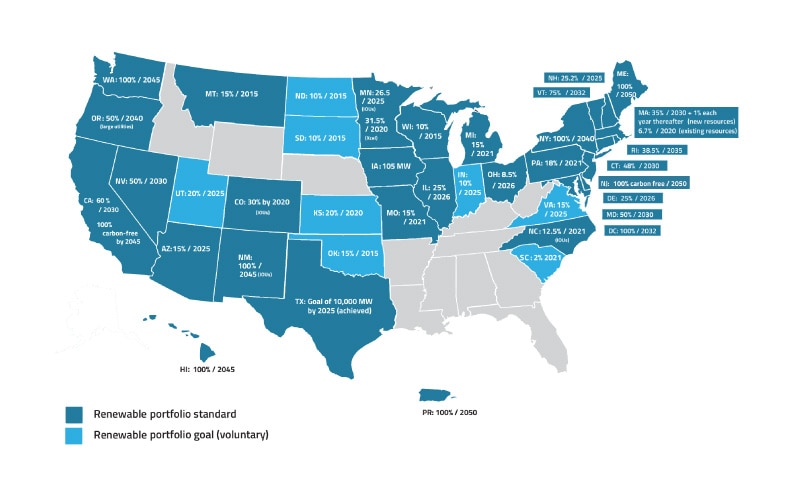
According to data as of August 2, 2019.
Source: EnerKnol Inc., an energy research and policy platform covering the North American energy sector.
Renewable energy: The price is right
Renewable energy costs hit a record low last year. The average cost of electricity from renewables universally declined: Utility-scale solar was down by 26%, bioenergy by 14%, solar photovoltaics and onshore wind by 13% each, hydropower by 12%, and geothermal and offshore wind by 1% each.3 Since 2010, the cost of wind power is down 49% and solar is down by 85%. Bloomberg New Energy Finance predicts the world will invest $4.2 trillion in solar power generation over the next three decades. That means solar will go from 2% of global power generation now to 22% in 2050. The grid will need to be modernized to accommodate this dramatic increase in bi-directional power flows.
Increasing demand: more power please
Utility companies have to prepare for increased demand from three main sources — smart devices powered by IoT, data centers to power the internet itself and electric vehicles. More and more IoT devices are flooding the market and showing up in homes everywhere. That increase leads to a higher electric demand. By 2025, 75.44 billion IoT connected devices are predicted.
By 2025, experts predict a fivefold increase of about 75.44 billion IoT devices
That’s a fivefold increase over a decade.4 Data traffic is expected to more than double every four years. Before you Google that … here’s something to think about: Google says a single search uses as much energy as does turning on a 60-watt light bulb for 17 seconds, and emits 0.2 grams of carbon dioxide. In 2017, U.S.-based data centers alone used more than 90 billion kilowatt-hours of electricity. On a global scale, they consume about 416 terawatt-hours, use more than 2% of the world’s electricity and emit about as much carbon dioxide as does the airline industry.5 Not only do the processors in big data centers use a lot of energy, but it also takes just as much energy to keep them from overheating.
You can also see increasing electric demand in driveways across the country. More than 350,000 new electric vehicles are expected to be sold in the U.S. by 2020. EVs still make up just 2% of the total number of cars in the U.S., but by 2025, that number is expected to jump to 7%, with more than 1.1 million electric vehicles on the road.6 Charging all of those vehicles will increase electricity demand. General Motors estimates the Chevy Volt uses about 2,520 kilowatt-hours of energy every year. That’s less than a typical air conditioner or water heater. Of course, the actual energy used will depend on how far and how often the owner drives the car.
The National Renewable Energy Laboratory predicts steady growth in energy demand over the next 30 years as more and more people start driving EVs. Utilities could see demand change from stagnant to sustained growth of 80 terawatt-hours every year.7 The U.S. has just under 1.2 million megawatts of electric generation capacity as of March 2018. Forty-three percent is generated by natural gas and 23% by coal. Nuclear, hydro and wind combined make up one-quarter of the capacity, with solar generating 2.6%.8
Grid power flow complexity
Much of the nations grid is horribly out-of-date, some of it is more than 100 years old. That’s already causing problems, and more are on the way. Reverse power flows from DERs and increasing consumer demand from electric vehicles and data centers are changing the load profile.
Our national utility grid lacks the capability to accommodate highly variable two-way power flows from renewable energy sources such as solar panels and wind turbines. This makes it difficult to use distributed energy resources, such as home solar panels, batteries and electric vehicles, to their full potential. Distribution systems were built for power flowing in one direction — from the power plant to the customer. Now it is flowing both ways, as homeowners sell their extra power back to the grid. And that’s just part of the problem. Older grid technology also creates more wildfires and safety concerns.
Updating the planning process
It’s not just the utility infrastructure that’s aging — the planning capabilities and communication technology are outdated as well. Going forward, utilities will have to transform the planning process to consider how DERs can expand while keeping the system reliable. Currently, system modeling tools are not integrated and rely on assumptions and time-consuming manual assessments of circuit capacity. These tools need to be updated so operators have precise information about distribution circuit conditions as DERs increase.
Before an asset is deployed, extensive planning and forecasting are crucial to making accurate decisions about future infrastructure needs. The addition of DERs is making the capability even more important, as real-time load and generation throughout the grid is required to accurately predict load profile. Utilities are moving away from the existing point-in-time forecast, which uses in-house tools to make a time-series forecast using advanced statistical methods and incorporating data elements like weather data, economic data, load growth, and DER forecast.
Reliability and resilience
Aging grids are not prepared to accommodate the complexity of bidirectional, intermittent power flows from distributed energy resources. With more and more DERs connected to the grid, congestion is creating an unpredictable strain on the network. Too much electricity demand or too much electricity generation can cause disruptions at the circuit, substation and system levels. In some cases, traditional grid reinforcement techniques can’t keep pace with this strain. That can damage circuit segment cables, fuses and transformers, and cause voltage variability and outages across the distribution network. Modernizing the grid will improve system reliability and outage restoration, while supporting increased levels of DERs and two-way power flow. It’s important to get in front of potential congestion issues now to avoid safety and reliability issues down the line.

By modernizing the grid, utilities can reduce outages, fires, and loss of property and life.
Reducing property loss, wildfires and power outages are just a few benefits of grid modernization.
Having a modern grid allows electricity providers to instantaneously shut off power when a line touches something that causes it to spark. For example, remote switches allow a grid operator to move the power flow away from a transformer that’s getting too hot. When using older line technology, line contacts continue to spark. San Francisco-based Pacific Gas and Electric filed for bankruptcy after their power lines sparked the deadliest wildfire in California history — Northern California’s Camp Fire.9 By upgrading the grid, utility companies can dramatically reduce the risk of starting a fire, and their own liability.
Utility repairs can also be dangerous business. The 2018 Utilities Sector Serious Injuries and Fatalities Study found that electric utilities have a 32% SIF exposure rate. A modern grid can heal itself using software to monitor interruptions in power flow.
Modern grids are self-healing which can significantly reduce worker accidents and power outages.
If there is an outage, the smart grid has an automated reaction that helps restore power. Wireless devices can even tell workers where to find the damage.10 This helps prevent worker injuries and power outages.
The 21st-century grid
It’s time for the U.S. electrical grid to modernize in order to support DERs, manage increasing demand, and decrease pollution and carbonization.The solution lies in a combination of the following: A modern grid uses distribution automation to link sensors and controls, creating a reliable, flexible and agile grid. Volt/VAR optimization allows utilities to deliver energy in response to immediate demand. VVO takes real time analytics from the grid and uses them to regulate supply and demand. Substation automation helps the operations center receive and process data from transformers, breakers and capacitors. Grid management solutions improve two-way power flow by using situational awareness and a real-time, detailed view of demand. Wireless field area networks and wide area networks integrate device communication and operations.
The modern grid improves public safety. It’s reliable and even heals itself using self-assessments to detect problems and restore grid components. A modernized grid enables DER integration and adoption making it easy and affordable for customers to adopt new technology. Utilities also benefit by getting the most value from DERs. The grid wasn’t designed for power to flow both ways, but it’s time that it did. The benefits to the bottom line and the environment are too important to ignore.
References
- “While Colorado Is Ready For More Renewable Energy, The Grid Isn’t — For Now,” Colorado Public Radio, June 2019
- “State Renewable Portfolio Standards and Goals,” National Conference of State Legislatures, February 2019
- Renewable energy prices keep falling: When do they bottom out?” Utility Dive, May 2019
- “Internet of Things (IoT) connected devices installed base worldwide from 2015 to 2025 (in billions),” Statista, November 2016
- “Energy Hogs: Can World’s Huge Data Centers Be Made More Efficient?” Yale Environment 360, April 2018
- “US Electric Vehicle Loyalty and Volumes Reach Record Highs, according to IHS Markit,” IHS Markit, April 2019
- “EVs could drive 38% rise in US electricity demand, DOE lab finds,” Utility Dive, July 2018
- “New registrations for electric vehicles doubled in US since last year,” TechCrunch.com, April 2019
- “Northern California town of Paradise lost 90% of its populations after Camp Fire, data shows,” USA Today, July 2019
- “Our Regional Power Grid is ‘Smart’ and ‘Self-Healing,’” SDGE Newscenter, December 2018
